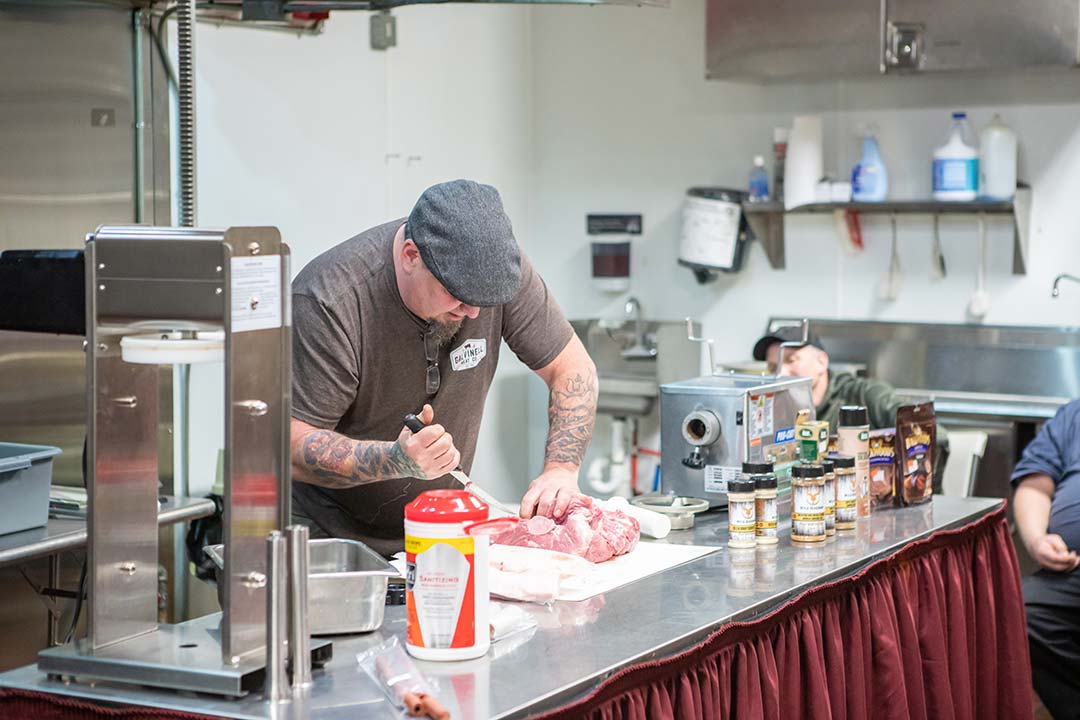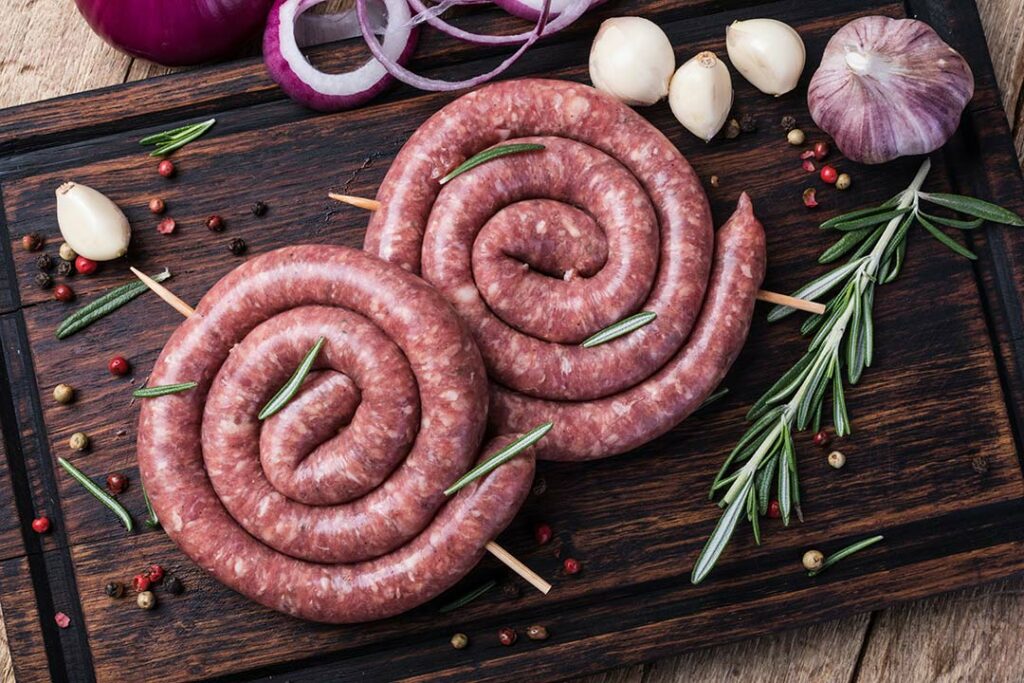Are you interested in making sausage, bologna, ham, jerky, snack sticks, and bacon at home? There is a lot to learn, but a little guidance goes a long way in preparing these delicious meats and snacks with confidence. Here is a handy list of guidelines you will want to refer to often.
Updated August 31, 2023
General Guidelines
Note: Temperatures given are in F.
Sodium nitrite (sometimes referred to as Insta Cure #1, Prague Powder, or pink curing salt) is the one you will use most frequently. The correct ratio for sodium nitrite (with the exception of bacon, see bacon section) is 1 ounce per 25 pounds of meat or 1 teaspoon per 5 pounds of meat. Buy sodium nitrite here.
Sodium nitrate (sometimes referred to as Insta Cure #2) is only to be used in whole muscle curing or the making of dry cured sausages or salamis.
Fresh Sausage
- Using venison? Add 20-30% fatty pork or pork fat.
- Using pork? Pork butts are perfect! Add up to 10% pork fat for really juicy sausages!
Before vacuum sealing fresh sausage, put it into bags or wrap it in plastic wrap and put the sausage into the freezer until it's very firm. This will keep it from getting smashed while vacuum sealing.
Seasoning Blends
- Legg’s Blend 10 Breakfast Sausage Seasoning
- LEM Backwoods Maple Breakfast Sausage Seasoning
- LEM Backwoods Chipotle Bourbon Seasoning
Browse all meat processing seasoning blends
Casings
If you're not making links, form it into patties for breakfast sausage or fry it loose for casseroles and other dishes.
Cooking Methods
Using a grill: Cook the fresh sausages at 350 degrees with medium smoke until the meat reaches an internal temperature of 160 degrees.
Using a stove: Brown the sausage in a skillet over medium heat until the internal temperature reaches 160 degrees.
Snack Sticks
- Using venison? Add 10–20% fatty pork, pork fat, bacon, or 70–80% lean ground beef.
- Using beef? Use 80–90% lean ground beef.
Seasoning Blends
These come with a cure packet.
- Legg’s Jalapeno Snack Stick Seasoning
- Legg’s Snack Stick Seasoning
- LEM Backwoods Original Snack Stick Seasoning
Browse all meat processing seasoning blends
Casings
Cooking Methods
Using a smoker: Smoke them at 150 degrees for 2 hours, then increase the temperature to 200 degrees until the internal temperature of the sticks hits 150 degrees (approximately 30–60 minutes longer).
Using an oven: Add 1 teaspoon of liquid smoke per 10 pounds of meat to the seasoning blend, then cook them at 200 degrees until the internal temperature of the sticks hits 150 degrees (approximately 1 hour).
Summer Sausage or Ring Bologna
- Using venison? Add 10–20% fatty pork, pork fat, bacon, or 70–80% lean ground beef.
- Using beef? Use 80-90% lean ground beef.
Seasoning Blends
These come with a cure packet.
Casings
Cooking Methods
Using a smoker: Smoke it at 150 degrees for 4 hours, then increase the temperature to 200 degrees until the internal temperature of the meat hits 150 degrees (approximately 1–2 more hours).
Using an oven: Add 1 teaspoon of liquid smoke per 10 pounds of meat to the seasoning blend, then cook it at 200 degrees until the internal temperature of the meat hits 150 degrees (approximately 3 hours).
Bologna
- Using venison? Add 10–20% fatty pork, pork fat, bacon, or 70–80% lean ground beef.
- Using beef? Use 80-90% lean ground beef.
Seasoning
- Legg’s Bologna & Frankfurter Seasoning
- LEM Backwoods Bologna Seasoning
- LEM Backwoods Trail Bologna Seasoning
Casings
Cooking Methods
Using a smoker: Smoke the bologna at 150 degrees for 6 hours, then increase the temperature to 200 degrees until the internal temperature of the meat hits 150 degrees (approximately 4–6 more hours).
Using an oven: Add 1 teaspoon of liquid smoke per 10 pounds of meat to the seasoning blend, then cook it at 200 degrees until the internal temp of the meat hits 150 degrees (approximately 6–7 hours).
Muscle Jerky
- Using venison? The hindquarters or the backstraps make great muscle jerky!
- Using beef? Brisket flat, top round, or eye round are great choices.
Seasonings (available in our store)
- LEM Backwoods Original Jerky Seasoning
- LEM Backwoods Hickory Jerky Seasoning
- LEM Backwoods Cracked Pepper Jerky Seasoning
Browse all meat processing seasoning blends
Preparation Methods
Using a smoker: Smoke the jerky at 150 degrees until it is rigid, but tender enough that it doesn't snap when bent (approximately 6–8 hours).
Using an oven: Add 1 teaspoon of liquid smoke per 10 pounds of meat to the marinade. Set the oven as low as possible (usually 175–200 degrees), and prop the door open 1–2” to let some of the heat escape. Cook the jerky until it is rigid, but tender enough that it doesn't snap when bent (approximately 4–6 hours).
Using a dehydrator: Add 1 teaspoon of liquid smoke per 10 pounds of meat to the marinade. Set the dehydrator at 150 degrees or as low as possible. Dry the meat until it is rigid, but tender enough that it doesn't snap when bent (approximately 6–8 hours).
Formed Jerky
- Using venison? Any ground venison works fine.
- Using beef? Use the leanest ground beef you can possibly find!
See "Muscle Jerky" for recommended seasonings.
Preparation Methods
Using a smoker: Smoke the jerky at 150 degrees until it is rigid, but tender enough that it doesn't snap when bent (approximately 6–8 hours).
Using an oven: Add 1 teaspoon of liquid smoke per 10 pounds of meat to the seasoning blend. Set the oven as low as possible (usually 175–200 degrees), and prop the door open 1–2” to let some of the heat escape. Cook the jerky until it is rigid, but tender enough that it doesn't snap when bent (approximately 2–3 hours).
Using a dehydrator: Add 1 teaspoon of liquid smoke per 10 pounds of meat to the seasoning blend. Set the dehydrator at 150 degrees or as low as possible. Dry the meat until it is rigid, but tender enough that it doesn't snap when bent (approximately 3–4 hours).
Bacon
Use a skinned pork belly.
Basic cure for a 10-pound pork belly (adjust as needed to match the weight):
- 4 ounces kosher salt
- 2.25 ounces dark brown sugar
- 0.75 ounces cure #1 (sodium nitrite)
For a maple bacon, slather the belly in maple syrup before applying the cure mixture. For a peppered bacon, add 3 tablespoons coarsely-ground black pepper to the basic cure mixture and lightly dust the belly with more before refrigerating for the pellicle formation.
Mix the cure ingredients well and apply the cure to all sides of the belly. Put the belly in a large zip lock bag or covered container. Refrigerate it for five or six days and flip the belly once a day. Very thick bellies might take an extra day or two to cure; the belly should feel fairly firm to the touch.
After the curing process is completed, remove the belly from the bag, rinse it well, and soak it in cold water for 30 minutes. Then pat it dry with paper towels, set it on a wire rack on a rimmed baking sheet, and put it back in the refrigerator uncovered for 18–24 hours to form a pellicle.
Preparation Methods
Using a smoker: Smoke the belly at 150 degrees for 2 hours, then at 200 degrees until the internal temperature of the bacon hits 150 degrees (approximately 2–3 more hours).
Using an oven: Cook the belly at 200 degrees until the internal temperature of the bacon reaches 150 degrees (approximately 3–4 hours).
Let it cool on the counter for 30–40 minutes before slicing, refrigerating, or freezing it.
We carry a full line of meat processing equipment and supplies, including grinders, stuffers, seasoning blends, and casings. Our staff is also happy to help you with your meat processing questions! Visit us during store hours or browse some of our products in our online catalog here:
Location:
Meadow Creek Barbecue Supply
140 W Main St
New Holland, PA 17557
Phone: (717) 355-0779
Hours:
Monday – Thursday: 8:00 am – 4:30 pm
Friday: 8:00 am – 7:00 pm
Saturday: 8:00 am – 12:00 pm
Sunday: Closed


